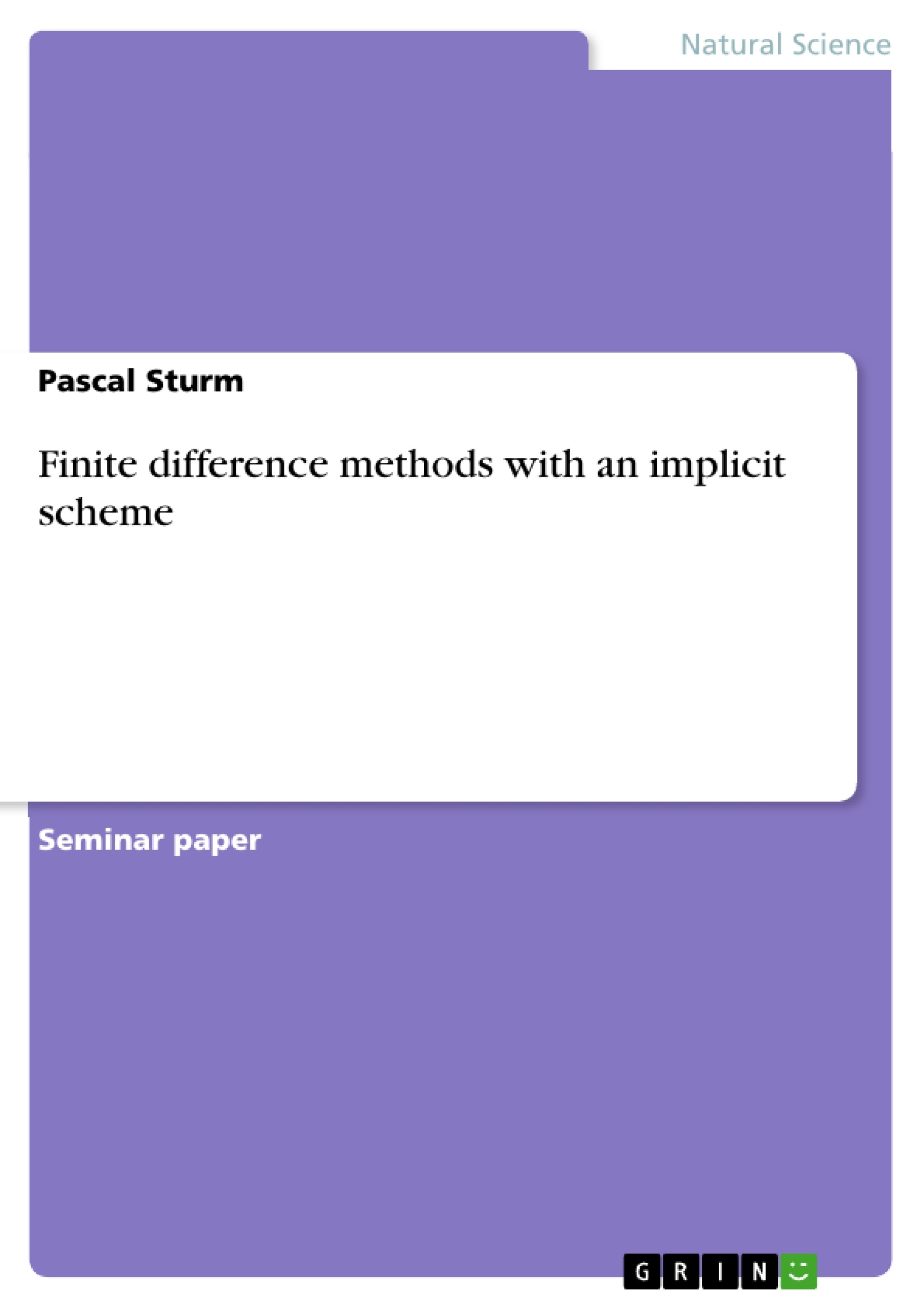Using an explicit scheme for an application of finite difference methods may lead to stability issues. If one wants to increase the accuracy by raising the number of spatial grid points, the number of time intervals have to be increased to a certain extent in order to sustain a converging behavior.
As for quite accurate results ridiculously many grid points in time are needed, the practical use of the explicit scheme is rather limited due to high computational effort. Implicit methods for finite difference methods are designed to overcome these stability limitations imposed by the already mentioned convergence restrictions. Since such methods are unconditionally stable, both accuracy and limited computational effort can be combined.
This text offers an introductory treatment of Finite Difference Methods employing an implicit scheme. It includes a theoretical derivation of the implicit scheme and the Crank-Nicolson scheme, a numerical application to European puts as well as a theoretical discussion and comparison of the truncation error for both schemes. Finally, Richard-Extrapolation is introduced as a nice tool for lowering the truncation error.
Inhaltsverzeichnis (Table of Contents)
- 1 Theoretical Aspects of Implicit Finite Difference Methods
- 1.1 Derivation of a Fully Implicit Scheme
- 1.1.1 Exemplary Boundary Conditions for a European Put
- 1.1.2 The Fully Implicit Scheme in Matrix Notation
- 1.2 Solving Tridiagonal System of Linear Equations
- 1.3 Derivation of the Crank-Nicolson Scheme
- 1.3.1 Exemplary Boundary Conditions for a European Put
- 1.3.2 The Crank-Nicolson Scheme in Matrix Notation
- 1.1 Derivation of a Fully Implicit Scheme
- 2 Numerical Application for a European Put
- 2.1 Results and Interpretations
- 2.2 Technical Implementation
- 3 Truncation Error and Rate of Convergence
- 3.1 Richardson Extrapolation for the Fully Implicit Scheme
- 3.2 Richardson Extrapolation for Crank-Nicolson Scheme
- 3.3 Preliminary Efficiency Analysis
- 3.4 Technical Implementation
Zielsetzung und Themenschwerpunkte (Objectives and Key Themes)
This work explores the application of implicit finite difference methods in the context of pricing financial derivatives. The objective is to demonstrate how these methods overcome the stability limitations of explicit schemes, enabling more efficient and accurate calculations. The text examines the derivation and implementation of both fully implicit and Crank-Nicolson schemes, exploring their numerical properties and convergence characteristics. This includes analyzing the truncation error, rate of convergence, and efficiency of each method through rigorous computational simulations.
- Implicit Finite Difference Methods for Derivative Pricing
- Comparison of Fully Implicit and Crank-Nicolson Schemes
- Truncation Error and Rate of Convergence Analysis
- Efficiency Analysis of Numerical Solutions
- Stability and Convergence Properties of Implicit Schemes
Zusammenfassung der Kapitel (Chapter Summaries)
Chapter 1 provides a theoretical foundation for implicit finite difference methods. It covers the derivation of a fully implicit scheme for pricing financial derivatives, including the specification of boundary conditions. The chapter also outlines the Crank-Nicolson scheme, discussing its advantages and drawbacks. Chapter 2 focuses on the numerical application of the fully implicit scheme to price a European put option. It presents the results obtained and discusses their interpretations. The chapter also details the technical implementation aspects. Chapter 3 delves into the analysis of truncation error and rate of convergence for both the fully implicit and Crank-Nicolson schemes. The chapter employs Richardson extrapolation to improve the accuracy of the numerical solutions. It further explores the efficiency analysis of the schemes, highlighting their computational performance.
Schlüsselwörter (Keywords)
Implicit finite difference methods, European put option, Crank-Nicolson scheme, truncation error, rate of convergence, efficiency analysis, Richardson extrapolation, stability, convergence, numerical solutions, derivative pricing.
- Quote paper
- Pascal Sturm (Author), 2016, Finite difference methods with an implicit scheme, Munich, GRIN Verlag, https://www.hausarbeiten.de/document/373359


